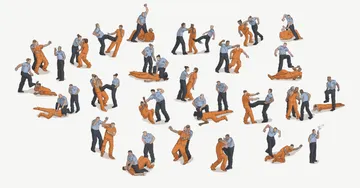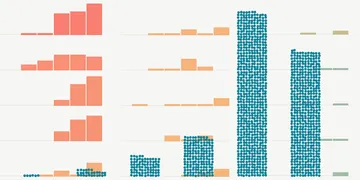This is The Marshall Project’s Closing Argument newsletter, a weekly deep dive into a key criminal justice issue. Want this delivered to your inbox? Sign up for future newsletters.
On Thursday night, President Donald Trump visited a U.S. Park Police facility in southeast Washington, D.C., turning what was initially billed as the president going “on patrol” into a much less dramatic affair. He handed out pizza and hamburgers to roughly 300 law enforcement personnel, thanking them for their work in the city.
It was the latest turn in a nearly two-week odyssey since Trump declared a “public safety emergency” in the nation’s capital and invoked rarely-used statutory powers to try to override local control of policing and criminal justice in the city. The resulting fallout has included hundreds of arrests, and widespread opposition from residents, city leaders and legal experts.
The most unprecedented part of Trump’s Aug. 11 announcement had a very brief shelf life. Within about a day of naming Terry Cole, the administrator of the Drug Enforcement Administration, as “emergency police commissioner,” a federal judge took a skeptical view on whether such a move would be legal.
The Department of Justice subsequently rescinded the effort to take over the Metropolitan Police Department, but secured a concession from city leadership: full cooperation with federal immigration enforcement. Under the arrangement, Cole can request police assistance, but does not have command authority over officers.
Instead, the takeover has been more of a parallel federal presence, with the administration flooding the district with national guard personnel, FBI, DEA, ICE and other federal agents. About 2,000 guardspeople have been deployed, with those numbers buoyed by National Guard troops sent from Republican-led states in recent days. Guard members have mostly been stationed at federal landmarks and high-traffic areas. Initially, guard personnel were unarmed, but on Friday, Defense Secretary Pete Hegseth authorized arming National Guard forces patrolling the city.
Roughly 500 federal agents, meanwhile, have been patrolling neighborhoods on foot, conducting checkpoints, traffic stops, and immigration enforcement sweeps.
After early reports from some people in the city’s high-crime neighborhoods that none of the government’s stated crime-fighting enthusiasm had made it there, the White House released data suggesting that half of all non-immigration arrests during the surge had been in high-crime neighborhoods. Overall there is a lack of detailed data on who is arresting whom and for what alleged crimes, but most of the police interactions so far have been citations and arrests for minor crimes, according to the local ABC affiliate.
Jeanine Pirro, the U.S. Attorney for the District, has told prosecutors in her office to seek maximum charges in all D.C. arrests, except for one unexpected caveat: This week she announced her office would not prosecute gun possession cases involving shotguns or rifles, including AR-style rifles, citing constitutional concerns.
According to multiple reports, the takeover has chilled public activity in the city. Data from Open Table showed restaurant reservations in the district were down by as much as 31% a day compared to last year during the first week of the takeover, then rebounded on Monday, Aug. 18. The dip in activity was even more pronounced in immigrant neighborhoods, with one fruit seller telling The Associated Press that business is now worse than during the early days of the pandemic.
The president made a number of false and misleading claims about crime in the district when explaining the rationale for his takeover effort. Those claims have been picked apart in detail by numerous observers and publications.
D.C. does experience higher rates of homicide, carjacking and armed robbery than many other large American cities, but violent crime has declined significantly over the past year by most metrics. Trump has attacked the city and FBI crime statistics as false, citing one MPD commander who has been accused of manipulating statistics. But the department has countered that even if true, such an effort would not implicate city-wide data — a conclusion shared by at least one crime data expert.
Many residents of the district do have concerns about crime, and have expressed general support for efforts to bring crime rates down, but Trump’s unilateral takeover has been extraordinarily unpopular. According to polling released this week, nearly 80% of residents either somewhat or strongly oppose the efforts. The Washington Post-Schar School poll also found that residents feel less safe under the takeover than before it.
Immigration enforcement has made up a large part of the policing surge. As of Tuesday, nearly half of the arrests “since the start of operations” in D.C. have been of undocumented people, an administration spokesperson told The Wall Street Journal. That has been largely driven by ICE targeting locations like bilingual daycare centers, Spanish-speaking churches and traffic stops to check the citizenship status of delivery drivers on mopeds.
Some have worried from the start that Trump’s efforts in D.C. might be a dress rehearsal for efforts in other Democratic-led cities — indeed, Trump vaguely threatened as much. Others have poured cold water on that suspicion, pointing out that the president has unique legal authority over the district that doesn’t translate elsewhere.
Increasingly, it seems as though both camps may be proven right. The president’s control over D.C. is undeniably a special case, and the effort to take over the police department there in earnest lasted barely a day. But Democratic leaders across the country worry that elements of the immigration enforcement surge, and the administration’s successful efforts at bypassing the district’s “sanctuary city” protections, may be predictive of what the feds will try elsewhere, Politico reported this week.
For many commentators, that’s always been the point. They argue that the surge was never about crime, but about Trump projecting dominance — particularly over cities that have long resisted his agenda.
“The deployment of out-of-state National Guard troops and more federal agents onto D.C. streets is a brazen abuse of power meant to intimidate and create fear in the nation’s capital,” said Monica Hopkins, executive director of the American Civil Liberties Union of the District of Columbia. “This is an unnecessary overstep to micromanage D.C. under a phony emergency, causing real harm to residents and visitors — all to advance the Trump administration’s political agenda.”

